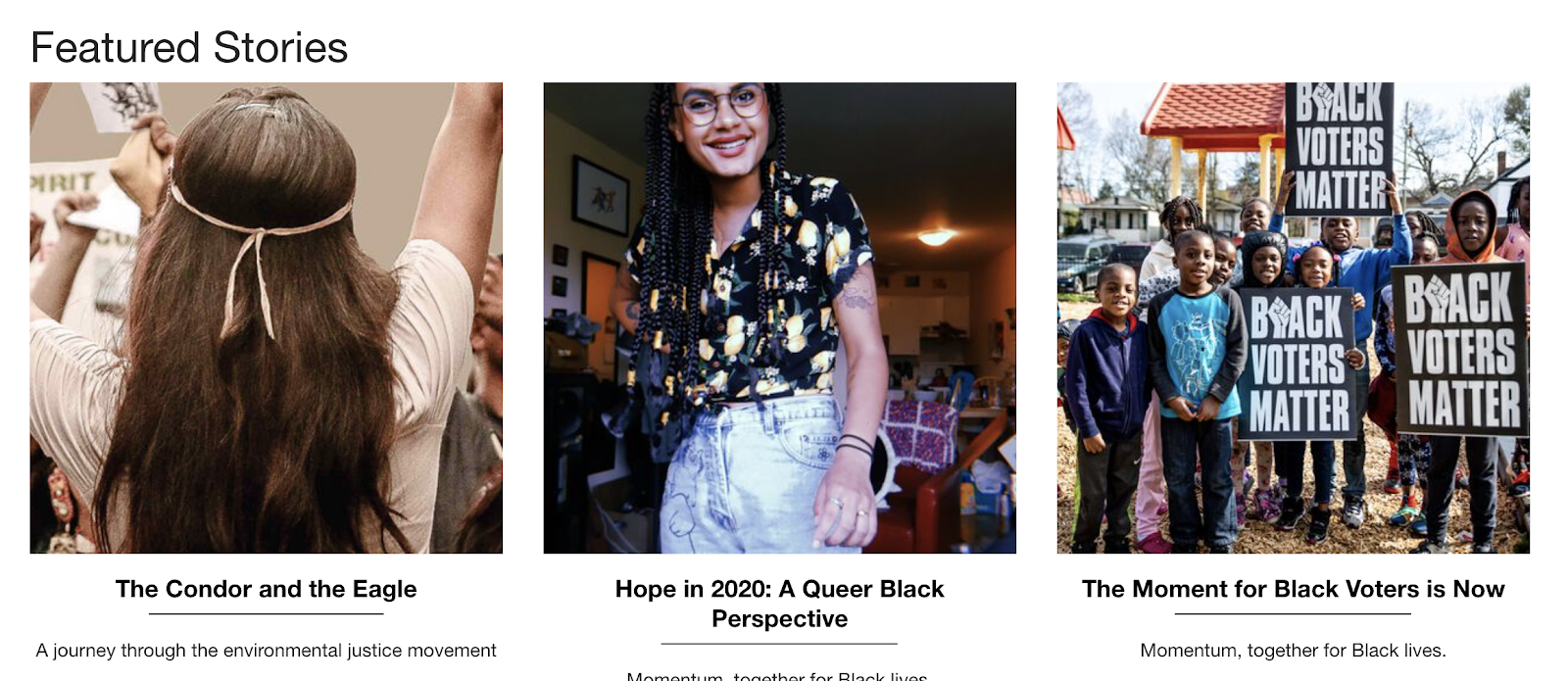Well, we can tell you right now that we’ve stumbled upon a winning strategy, but it’s not going to be an instant victory.
Up until now, many of us marketers have treated SEO like a game. We look for ways to outsmart Google... unnaturally stuffing our content with keywords, begging for backlinks from big domains, and feeding the world’s largest search engine precisely what we think it wants.
See how we help clients with SEO.
Somewhere along the path of conquering the SERPs, we’ve lost sight of the reasons we created our products or services in the first place.
We’ve watched our mission and core values get buried beneath our brand manual’s unread pages and started caring more about rankings than our content’s quality and how it serves our audience.
Today, we’re here to challenge your current content marketing strategy. Instead of centering your content generation around search volume, we want you to get back in touch with your company’s “WHY” or the inspiration behind your brand’s existence.
It all starts with a little thing called mission-driven content marketing.
What Exactly is Mission-Driven Content Marketing?
A few members of our team had the pleasure of attending INBOUND2020 this past September. During our favorite marketing conference, we tuned in for Dale Bertrand’s “The End of Technical SEO: How Google’s AI Forces SEO Strategies to be More Human” intriguing session.
The President and Founder of Fire&Spark used his 30 minutes in the INBOUND limelight to urge listeners to take a more “human approach to SEO.”
Oh, here we go… you might have thought. C’mon, we’ve all heard that “be more human” buzz term before, right? Yeah, yeah.
Yet, finally, someone told us what that really means to them.
“Your SEO needs a mission,” Dale said.
Interesting… At face value, that seems obvious. Yet, if you really think about it, how often do you give your content a very different “mission” than your company’s mission statement defines?
All the damn time. Most marketer’s content has the “ranking” mission: it was created to get organic traffic and bring in conversions. But can you tie a recent blog or ebook you created back to how it directly connects to one of your business’ core values?
Mission-driven marketing begs for a new look at content strategy.
It asks for every piece of content you produce to act as a leg beneath the table of your mission, first and foremost— before considering keyword targets.
Mission-driven content marketing is about getting back to our company’s roots… and creating content that is derived from the center of your business’ core. It’s about creating content that matters.
Content that helps to achieve something more than vanity metrics like website traffic.
Content that advocates your mission.
If Not for Website Traffic, then for What?
Why create purpose-driven content? What’s the ROI?, you might posit.
Perhaps the better question is, why would you not create content that supports your business’ purpose? Every blog you write, every podcast or video you record, every ebook you design absolutely needs a worthwhile return on investment or effort.
But if your only metrics for success are page views and SERP positions, you’re missing important KPIs right before your eyes…

Mission-driven content inspires folks who support your same passion and beliefs. Think more...
- Shares. When someone supports your message, they’re more likely to share your content with their audience, both online and off, spreading awareness of or web traffic to your brand. We’re not just talking about social shares here, people. We mean websites backlinking to your content because it makes them feel something. We mean an inspired reader texting a friend, “Hey, you need to read this.” We mean any and every way a person cares to share a story that resonates with them on an emotional or personal level.
- Engagement. Those who support your message will be more willing to react or talk about it, both online and off, flooding more eyes and ears to your brand and cause. This is those vanity metrics we can’t forget like “Likes/Reactions” and “Comments.” These are the untrackable moments, like casual conversations over coffee about an intriguing topic. It’s building a community who talks about your message in a Facebook Group or on a forum. It’s any and every way a person engages in the conversation you’re starting.
- Advocacy. A person who believes in your message equally wishes to advocate your shared cause. This is someone going out and buying your product and giving it a big shout-out on Instagram for how it makes a remarkable difference. It’s someone recommending your service, not because it’s the best out there, but because of the passion they see in your execution and how them supporting a brand that supports their cause connects your big-picture visions. It’s any and every way a you and a brand advocate a similar message.
Examples of Mission-Focused Content
Real-life examples can help nearly everyone to better understand a new concept. Let’s look at a few brands who regularly push out mission-driven content:
Patagonia
The sportswear brand Patagonia is known just as much for its high-quality outdoor jackets as it is for its advocacy towards improving the environment. A world with less pollution, landscape destruction, and manmade influence is a more natural place where outdoor recreationalists can enjoy the beautiful world we live in.
The website has an entire tab on its navigation bar called “Activism” for readers to learn about “The Conflicts” Patagonia strives to change, from oil drilling and element mining to land preservation disputes.
Instead of a hard push on their product line, Patagonia publishes mostly guest content written by activists and knowledgeable experts on all things outdoor, both here and on their “Stories” section (AKA, their blog).
To them, blogs are not articles instead to sell, they’re stories, or accounts and narratives by those who share the brand’s same values.

One story in particular is a terrific example of mission-driven content: All the Hemp That Fits.
In this post, we learn about the growth of a plant called hemp, which in its very cultivation aligns with Patagonia’s values. In the story, we learn that hemp’s long center taproot deeply penetrates even the hardest and most nutrient-depleted ground, which replenishes vital soil nutrients and prevents erosion.

We also learn that the plant requires no synthetic fertilizer to produce and often requires no irrigation or pesticides to grow successfully.
After educating readers on what a sustainable, environmentally-friendly and even beneficial crop hemp is, we learn that hemp fiber’s breathability, natural odor-mitigating properties, and abrasion resistance also make it an ideal product for their sports line activewear.
The materials and methods Patagonia mindfully chooses to make their products align holistically with their mission— and the message they push is one of education vs. marketing. For those with the same resolve for sustainable clothing and reducing their environmental footprint, they’re more likely to share, engage with, and advocate the same cause, and conveniently enough, promote Patagonia’s brand by association.
Lush
While Lush produces cosmetic products, the company is also hard at work ensuring that every step they take supports their mission and company core values— and boy, do they have a lot of them!
Lush believes in ethical sourcing and buying of the materials that go into their lotions, shampoos, conditioners, and all their health and beauty lines. In addition, many of their products come “naked,” without packaging, to avoid waste of plastic and other materials normally used in marketing and sales. Not only do they care about how they’re impacting the environment with production, but they also are strong opposers of animal testing in the beauty and cosmetic industry.

Similar to Patagonia, Lush’s blog is called their “Stories” hub.

This brand takes a strong voice about controversial, yet important causes.
For instance, here they tease a new documentary they are virtually hosting about global warming, told from the perspective of four Indigenous leaders. Not only will Lush be screening the film, but they’ll be holding a live discussion and donating profits from ticket sales to campaigns that support Indigenous and other people-of-color-led initiatives working for transformative social change.
Lush’s stance on “climate justice” puts both a spotlight on their cause and gets folks sharing, talking about, and attending an event that ultimately creates trust and admiration for their brand.
In addition to their Stories, Lush is an organization that proudly supports charity, with a whole campaign around a lotion line they call “Charity Pot.” The container of every Charity Pot lotion features an important cause to Lush, wherein customers get to choose with charity they’ll be supporting with their purchase. From animal welfare and human rights to environmental conservation, every lotion sold donates a portion of the profit to these hand-selected organizations and charities.
Lush also helps to advocate for these charities’ missions on their blog, featuring guest posts as a platform for awareness and support, like this article from The Ocean Legacy Foundation.

As a happy benefit, the organization that Lush features then ends up sharing the Lush Story with their network of devoted followers, getting the brand more views and engagement.
Google and search engines start to see these shares, views, and interactions and want to surface content that users appear to find helpful, serving this content in the SERPs. Suddenly, Lush has an SEO strategy without ever really optimizing for technical keywords or ranking factors.
Beyond SEO, Lush’s powerful purpose-driven messaging can be seen all across their marketing efforts. The community engagement they see is an immeasurable return on effort for both their causes and their brand, making them a highly-revered figure for their devotion to their mission.
Why Don’t More Brands Create Mission-Driven Content?
We speculate there are few things holding more brands back away from taking a purpose-driven content marketing approach:
Rigidity around the Value of Technical SEO
Some folks still strongly believe that the only way to organically rank is to optimize the shit out of their content.
THE COUNTER: While optimizing can be an important SEO strategy, it isn’t the only one. Don’t forget that Google accounts for engagement and shares too. Some brands have enough of a following or make big enough connections that they get enough reactions to tip search engines off to its relevance, without a direct SEO goal.
Google begins to surface the content because it sees the material is getting activity and naturally addresses the topic without keyword stuffing or red-flag ranking no-no’s.
Fear of Adopting a Strong Stance
Neutrality is perceived as safe. Neutrality is often the most politically correct route and keeps brand’s out of the negative spotlight, oftentimes pleasing the C-suite.
THE COUNTER: Neutrality can also be boring and flat. Companies often find themselves trying to balance on the wobbly tightrope of saying too much and not saying enough, only to find that their lack of opinion ultimately dissuades customers. The Black Lives Matter movement was a prime example: brands were slung mud both for voicing their support and for not saying anything at all. In the end, having a strong stance helps you to build a community of loyal followers and gives your brand a bigger purpose than “make money.” This higher purpose feels and can be quite rewarding towards your cause, and makes your brand feel more authentic and real.
Lack of Education
Many brands simply never considered this idea of mission-driven content marketing and how it could transform their SEO game forever. To learn more about this idea, check out this video or share this article with your team.
Nail Down Your Mission & Core Values
In order to curate content that supports your brand’s mission and core values, you have to be confident in what those are. A surprising number of organizations develop these foundational ideas when they first open and never revisit them as the company evolves and changes— and even those who routinely visit them may not be taking actionable steps to apply these values to their content and SEO strategies.
Download our free Brand Plan ebook for help defining these important parts of your company’s purpose and culture, today.





